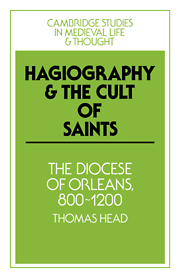Book contents
- Frontmatter
- Contents
- List of figures and maps
- Acknowledgements
- List of abbreviation
- INTRODUCTION
- 1 THE CAROLINGIAN PERIOD
- 2 THE CAPETIAN PERIOD
- 3 THE IDEAL OF SANCTITY: FORMATION, IMITATION, AND DISSEMINATION
- 4 THE POSTHUMOUS PATRONAGE OF THE SAINTS
- 5 SAINTLY PATRONAGE AND EPISCOPAL AUTHORITY AT THE ABBEY OF MICY
- 6 SAINTS, ABBOTS, AND ECCLESIASTICAL POLITICS AT FLEURY AND PITHIVIERS
- CONCLUSION
- Bibliography and references
- Index
6 - SAINTS, ABBOTS, AND ECCLESIASTICAL POLITICS AT FLEURY AND PITHIVIERS
Published online by Cambridge University Press: 22 September 2009
- Frontmatter
- Contents
- List of figures and maps
- Acknowledgements
- List of abbreviation
- INTRODUCTION
- 1 THE CAROLINGIAN PERIOD
- 2 THE CAPETIAN PERIOD
- 3 THE IDEAL OF SANCTITY: FORMATION, IMITATION, AND DISSEMINATION
- 4 THE POSTHUMOUS PATRONAGE OF THE SAINTS
- 5 SAINTLY PATRONAGE AND EPISCOPAL AUTHORITY AT THE ABBEY OF MICY
- 6 SAINTS, ABBOTS, AND ECCLESIASTICAL POLITICS AT FLEURY AND PITHIVIERS
- CONCLUSION
- Bibliography and references
- Index
Summary
SOCIAL CHANGE AND THE DEFENCE OF ECCLESIASTICAL PROPERTY
During the first decades of Capetian rule local magnates, both secular and ecclesiastical, sought to exert dominion over the inhabitants, institutions, and lands of their territories. The properties of monastic communities provided particularly tempting prizes. Such communities of the unarmed had to find ways of defending themselves and their possessions against attempts to assert external control, interference which was often backed by armed force. As Lemarignier has noted, ‘Vassalage and feudovassalic practices always carried within them the ferment of anarchy and a menace of disorder for society. Against them the leaders, whom we would call the public powers, were forced to seek some cure, with means differing according to the times.’
Under these circumstances the abbots and monks of Fleury supplemented the traditional protection provided by their ‘father’ Benedict by developing new ideas of saintly, or more accurately sacred, patronage. They appealed to law and the public powers as a supplement to – although certainly not a substitute for – the personal power exerted by their patron. Writers from the community in large part developed these ideas in a novel form of hagiographic literature, that is the lives of contemporary figures. The bishops of Orléans, for their part, resisted the new rights which the community of Fleury won in this fashion, rights which anticipated the celebrated immunities of Cluny. The bishops, too, appealed to a tradition of law and to the patronage provided by certain ‘fathers’ of the diocese.
- Type
- Chapter
- Information
- Hagiography and the Cult of SaintsThe Diocese of Orléans, 800–1200, pp. 235 - 281Publisher: Cambridge University PressPrint publication year: 1990



